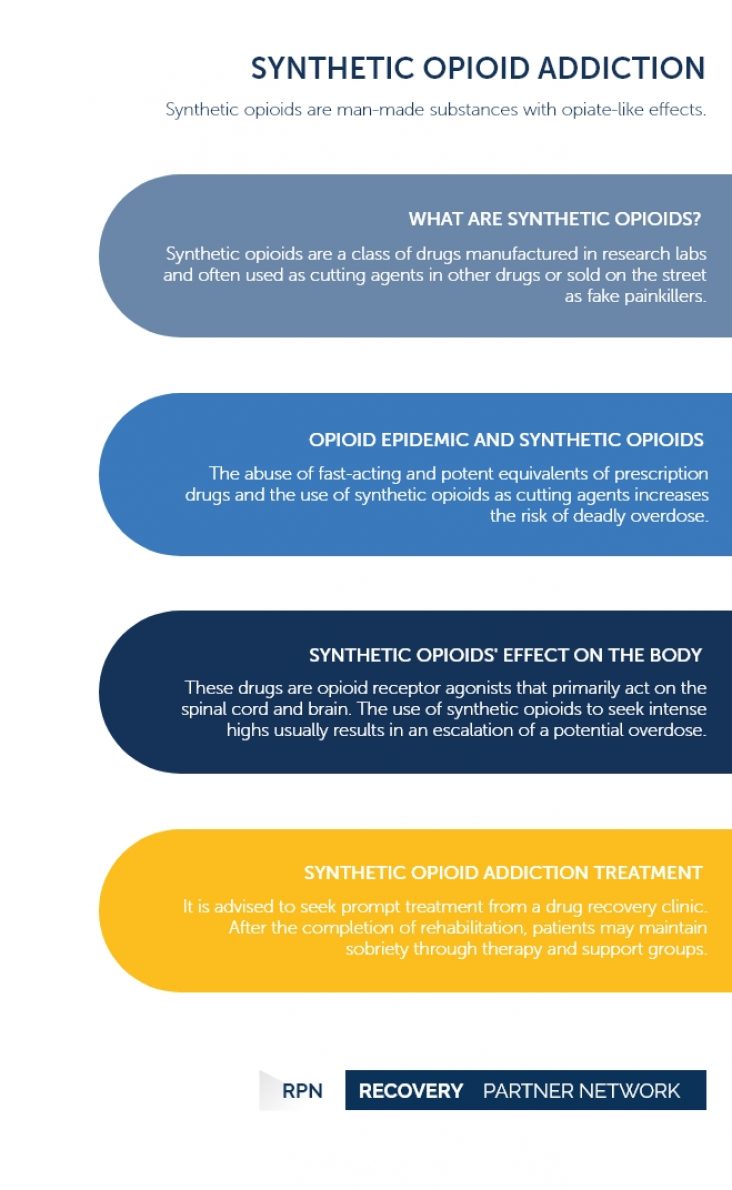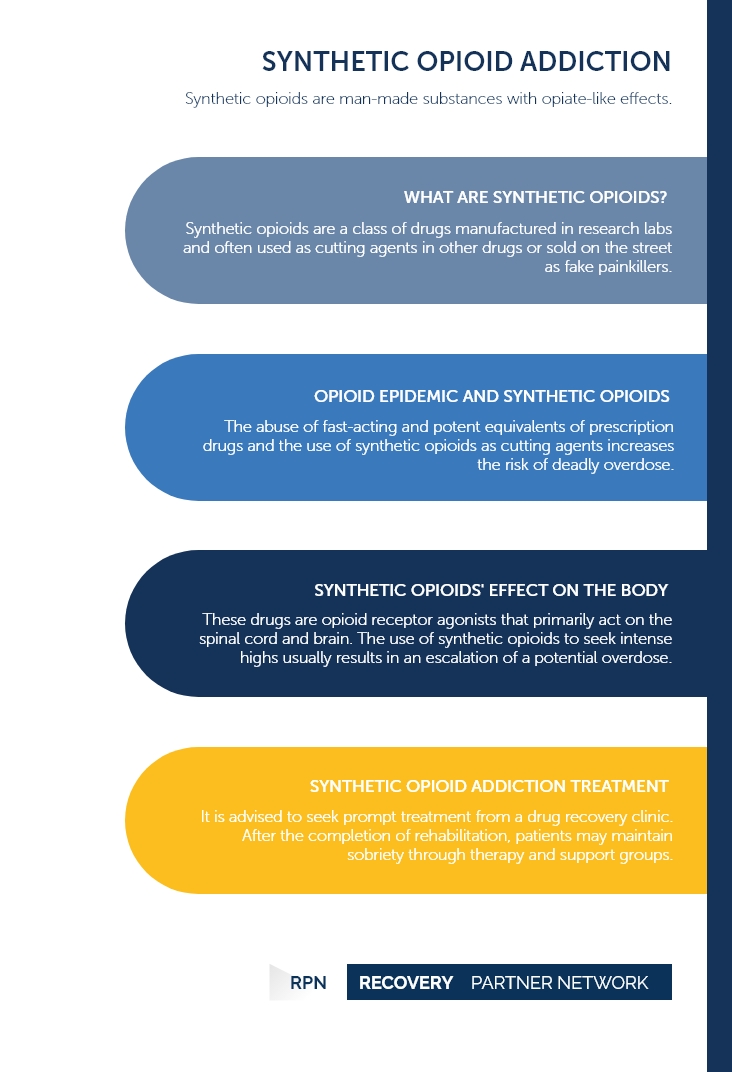Synthetic opioids are man-made substances with opiate-like effects.
Synthetic Opioid Addiction
Opioid
- Hydrocodone/paracetamol addiction
- Buprenorphine/Naloxone addiction
- Central nervous system depressant
- Codeine addiction
- Dextropropoxyphene addiction
- Fentanyl abuse
- Hydromorphone addiction
- How Long do Opioids Stay in Your System?
- Hydrocodone addiction
- Kava addiction and abuse
- Loperamide addiction
- Lortab addiction
- Medical prescription opioid
- Methadone addiction
- Morphine addiction
- Norco addiction
- NyQuil addiction
- Opioid use disorder
- OTC substance abuse
- Oxycodone addiction
- Oxycodone/paracetamol addiction
- Opioid epidemic
- Lean addiction
- Pethidine addiction
- Snorting Oxycodone
- Synthetic Opioids
- Tramadol addiction
Synthetic Opioids | Table of Contents
What are Synthetic Opioids?
Synthetic opioids are a class of drugs manufactured in research labs and are developed with a similar chemical structure comparable to opioids that are naturally obtained from the opium poppy. Although the chemical composition is similar between synthetic opioids and natural varieties, the specific compounds that make up synthetic drugs are completely human-made. This is different from natural or non-synthetic opioids, such as codeine and morphine, extracted from naturally occurring chemicals in opium pods, then modified and made into medications.
Synthetic opioids are often used as cutting agents in other drugs (especially cocaine and heroin) or as pills that are sold on the street as fake painkillers. Since synthetic opioids contain a higher level of potency, the risk of an overdose is highly likely.
Fentanyl is one of the most consumed synthetic opioids in the United States. Paul Janssen first discovered the potent drug in 1974 and by 2017 became one of the most widely used opioids in medical treatment. The drug is produced in large quantities by pharmaceutical companies for legal, clinical purposes and by street producers for illegal distribution. Currently, there are many fentanyl analogs, or slight variations of the drug that cause severe effects on the body, being introduced with no medical use.
Other synthetic opioids include:
- Methadone
- Butyryl fentanyl
- Furanylfentanyl
- Carfentanil
- 3-Methylfentanyl
- Acetyl fentanyl
- U-47700
- Tramadol
Carfentanil is one of the most potent opioids available in the market today. It is 10,000 times more potent than morphine and was created as an elephant tranquilizer. However, the powder form of the medication is used as a dangerous cutting agent in heroin. The increasing trend in the unlawful use of synthetic opioids has further increased the already high number of opioid overdose deaths in America.
FAQ
- What are synthetic opioids?
- How are synthetic opioids made?
- What are the most common synthetic opioids?
- What are synthetic opioids used for?
Synthetic opioids are man-made drugs that mimic the effects of naturally produced opioids such as heroin. Most synthetic drugs are classified as Schedule I substances.
Compounds used to create synthetic opioids are produced in pharmaceutical labs.
The most commonly used synthetic opioids are fentanyl, methadone, carfentanil, and tramadol.
Synthetic opioids are psychoactive drugs that are used as pain relievers.
Opioid Epidemic and Synthetic Opioids
Between 2017 and 2018, fatal drug overdoses increased by 10 percent in the US, reaching a total of over 72,000 Americans. The rise of even more deadly synthetic opioids has contributed to the large proportion of the still-growing death toll. Synthetic opioids, including fentanyl, overtook prescription opioids in 2016 as the cause of overdose deaths.
Death from prescription opioids began to stabilize in 2011, or even reversed, in many parts of the US. However, the development of synthetic opioids reignited this tragedy and is referred to as the “Second Wave” of the opioid epidemic. Drug trafficking organizations use synthetic opioids to imitate other drugs that are usually sold on the street as counterfeit medications. SUD patients who purchase such medications off the street often assume that they are buying Vicodin or Oxycontin but are actually purchasing more fast-acting and potent equivalents with higher overdose probabilities.
The use of carfentanil and fentanyl as cutting agents to powdered drugs such as cocaine and heroin increases the risk of deadly overdose even among users with high opioid tolerances. In Cuyahoga County, Cleveland, the office of medical examiners announced that 89.8 percent of heroin cases are associated with fentanyl.
FAQ
Natural opiates are produced through extracts of the poppy plant, while synthetic opioids are made through synthetic compounds that are created chemically.
Synthetic Opioids' Effect on the Body
The effect of synthetic opioids on the body is similar to that of black tar heroin and Percocet. These drugs are opioid receptor agonists that primarily act on the spinal cord and brain. Legally prescribed opioids are controlled by the FDA, with pre-determined potency and consistency. However, illegal synthetic opioids are unmonitored and unregulated, which results in an inconsistent product.
The use of synthetic opioids to seek intense highs usually results in an escalation of a potential overdose. Whether administered orally via pills, through nasal inhalation, sublingually (under the tongue), smoked or injected intravenously, the impacts are much the same. However, they may vary in magnitude, time of onset, according to the method of administration.
Effects of opioid abuse include:
- Pain relief
- Drowsiness
- Sedation
- Nausea
- Feelings of euphoria
As more potent synthetic opioids are produced, standard detection tests that can differentiate between opioids have yet to be made available to coroners, hospitals, and emergency medical personnel. However, data do not yet prove that synthetic opioids are less or more addictive than other opioids.
FAQ
- What are the risks of using synthetic opioids?
- How long do synthetic opioids remain in your system?
- What are the effects of fentanyl?
The risk of using synthetic opioids are constipation, itching, nausea, retching, lethargy, loss of consciousness, coma, and even overdose.
The duration in which synthetic opioids remain in the body depends upon the chemical structure of each synthetic opioid compound.
The effects of fentanyl include extreme happiness, drowsiness, nausea, confusion, constipation, and sedation.
Synthetic Opioid Statistics
- 1,100 Deaths: Carfentanil caused the death of over 1,100 individuals in Ohio in 2016.
- 50 Percent: Synthetic opioids accounted for nearly 50 percent of opioid-related deaths in 2016 (up from 14 percent in 2010).
- 19 Thousand: Synthetic opioids contributed to more than 19,413 deaths in 2016 (deaths commonly involving multiple opioids).
Synthetic Opioid Overdose
Since synthetic opioids are similar to natural opioids, the signs of addiction, dependence, and overdose on both opioids are quite similar. Fatal opioid overdoses are usually caused by the lack of oxygen when an individual stops breathing. Fentanyl is a longer-acting opiate, such as heroin, morphine, and oxycodone. The main distinction between oxycodone overdose and fentanyl or carfentanil is that the latter is considerably stronger than the former and has a relatively high risk of complications. The ability of fentanyl to start impacting the body soon after intake can lead to an even faster overdose.
Signs of a synthetic opioid overdose generally involve respiratory disruption that may cause slow breathing till it completely stops and the loss of consciousness. Synthetic opioid overdose is more likely to be life-threatening due to its high potency. However, an overdose can be reversed if medical attention is given immediately.
Higher doses of naloxone are given to reverse an overdose and allow the individual to start breathing normally again. Naloxone, an opioid receptor antagonist, can impede the action of all opioids in a person’s body, restore them and prevent them from getting higher. Narcan, the most common form of naloxone, comes in a 4 mg nasal spray. Multiple doses may be required to revive an individual fully.
Synthetic Opioid Addiction Treatment
Detoxification can be painful and, in some cases, fatal, regardless of the type of opioid being abused. Medical practitioners typically recommend that individuals seek prompt treatment from a drug recovery clinic since medical assistance increases the probability of success and effectiveness. After the completion of an inpatient drug rehabilitation or outpatient rehabilitation, patients can recover and maintain sobriety through therapy or support groups provided by aftercare programs.
Recovery Partner Network
We aim to educate and empower. If you feel our library of resources does not cover your specific need, reach out to us, and we would be happy to help.
STATISTICS
© Copyright 2025


